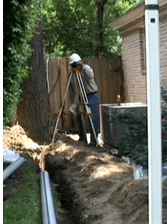
Proper Sloping
The land surrounding your home should slope away from the house, decreasing by about six inches in 10 feet. You can check your slope measurement by using two bamboo stakes and a 12-foot length of string. Just tie each end of the string to a stake, put one stake in the ground right next to your house and put the other stake in the ground about 10 feet out. The string should touch the ground next to your house, but if it’s touching the ground at the far stake, too, the slope around your home needs to be corrected.
You can add fill dirt or gravel around your home to achieve a proper slope. Concrete should also follow the same slope — if it’s broken or sagging, the concrete may actually be below grade and cause water to accumulate in the soil around your home.
Corrective Techniques
You can patch small cracks in concrete using cosmetic repairs or epoxy crack injections, but you may need to replace it if its crumbling or sloping toward the house. Consider using pavers to replace sidewalks and slab patios, to allow for better, more even water drainage.
If you have plants near your foundation, make sure they’re at least three feet away from exterior walls. If they’re too close to the house, every time you water your plants, you’re also watering your foundation.
Over time, excess moisture in the soil can put significant pressure on foundation walls, causing them to move and crack. So if you have a wet basement or crawl space, it may be a clue that you need foundation repair work.
